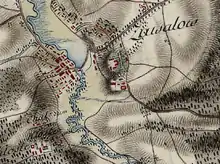Zavaliv
Zavaliv (Ukrainian: Завалів) (formerly Polish: Zawałów) is a village (formerly a town) in the western part of Pidhaitsi Raion (district) of Ternopil Oblast (province) of western Ukraine. Until 1990 Zavaliv belonged to Berezhany Raion. The village is situated on the right bank of Zolota Lypa (stands for "Golden Lime Tree") river, 18 km away from the district center of Pidhaitsi.

Hamlet Kamiana Hora was united with the village. Due to the resettlement of people, hamlet Zamche was removed from the registration data.
- Population of Zavaliv is 472 people
- Founded in 1395
- Telephone code is +380 3542
- Postal code is 48023
History

In 1725 Zavaliv was granted Magdeburg rights. In the second half of the 19th century, there were 191 houses and 1285 inhabitants (698 Ukrainian Greek-Catholics, 587 mainly Polish (some Ukrainian) Roman Catholics, 12 Germans, 17 Jews and a few Armenians) in the village. Zavaliv had a stone-built Polish Roman Catholic church and Ukrainian Greek-Catholic Church of Saint Nicholas the Wonderworker.
The history of intelligent, highly cultured family of Dmytro Huzar (1823–1908) is extremely interesting. He was the pastor of the village Zavaliv and now rests in peace on the village's cemetery, together with his beloved wife. Lubomyr Husar is his great-grandson. Dmytro Huzar arrived to Zavaliv in 1856. Served there in the parish until 1908. At the moment of arrival he already had two sons, Volodymyr and Yevhen. His son Lev (grandfather of Lubomyr Husar) and daughter Olha (in future - writer, translator, wife of Volodymyr Levytskyi) were born in Zavaliv. His Eminent Beatitude Lubomyr Husar visited Zavaliv and prayed for his relatives in the cemetery.[2]
Ukrainian writer Ivan Franko visited the village during the Easter holiday of 1883 and a month later, he wrote an article about two remarkable icons of local St. Nicholas church.